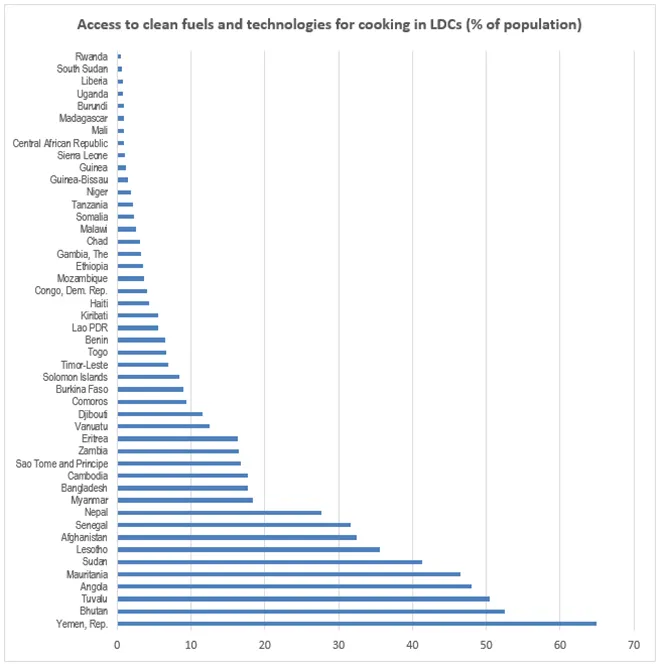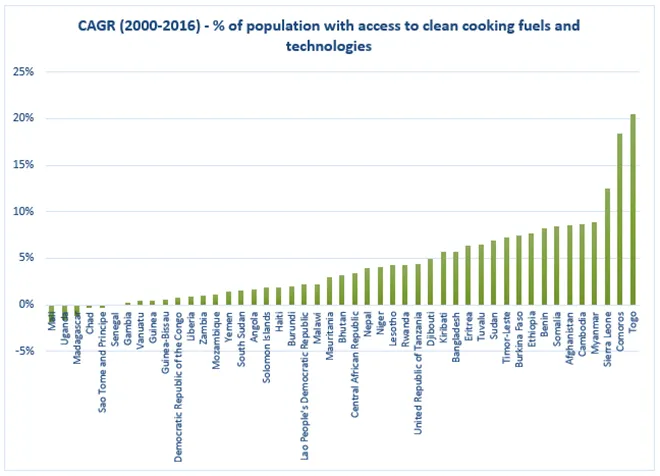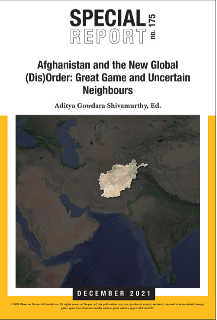
Only 14 percent of the population has access to clean cooking fuels and technologies in Least Developed Countries (LDC). One amongst the few indicators to measure Sustainable Development Goals (SDG) 7, i.e. to ensure affordable, reliable, sustainable, and modern energy to all by 2030, is proportion of population with primary reliance on clean fuels and technologies. The article looks at the challenges associated with achieving universal access to clean cooking fuels and technologies from the perspective of LDCs.
In 21 LDCs, less than 5 percent of the population had access to clean cooking fuels and technologies in the year 2016 ( figure 1). In eight LDCs, the corresponding figure was between 6 percent and 9 percent. Only two LDCs (Yemen and Bhutan) had 65 percent and 53 percent of its population with access to clean cooking fuels and technologies while rest of the countries had figures between 10 percent and 50 percent. The data clearly indicates that in about 29 LDCs, the population with access to clean cooking fuels and technologies is almost negligible,i.e., less than 10 percent.
Figure 1: Access to Clean Fuels and Technologies for Cooking in LDCs
 Source: Developed by author based on the data accessed from World Bank
Source: Developed by author based on the data accessed from World Bank
In 10 LDCs, only 1 percent of the population has access to clean cooking fuels and technologies. In such case, the initiatives associated with provision of clean cooking fuel and technology to all the households need to start almost from a nascent stage. This definitely would demand strong policy push at country level as well as diligent feasibility assessments and planning. There are cleaner cooking technologies like improved cook stoves and there are clean fuels and their technologies such as Liquid Petroleum Gas (LPG), electricity, biogas, and solar. The countries such as India and China initiated their nationwide programmes on improved cook stoves in 1980s. However, the thrust gradually shifted to LPG in most of the developing countries.
Improved cook stoves are the low-priced options and uses biomass such as firewood, coal, dung cakes, and agricultural residues as fuel. As per the World Health Organization (WHO) guidelines, the Particulate Matter (PM) for indoor emissions is recommended to be less than 2.5 milligrams per minute.Emission performance of forced draft stoves— they work at higher efficiency and requires power to operate a small blower—across India and African countries indicated that biomass stoves still needed improvement in emission performance. Thus, considering improved cook stoves would mean compromising on emission standards. Forced draft stoves are considered more efficient compared to natural draft stoves. Again, forced draft stoves uses pallets and electricity, which means creation of local market for pallets as well as provision of power supply with the stove. Behavioral practices are to be adjusted with the pallet-based stoves. Cost is associated with pallets if the households decides to buy pallets. Conversion of wood into pallets is a time consuming task which majority of the households may not opt for. In long run, clean cooking fuels and technologies (such as LPG or electricity) need to replace the improved cook stoves, if considered as an option. For example, Bhutan promoted improved cook stoves and biogas and achieved considerable achievements in the last three decades. However, the indoor air quality remains a challenge in Bhutan.
The most popular option of clean cooking fuel is LPG. The fuel has its own challenges of imports, development of bottling plants, creation of distribution network, and provision of refills. At user level, refilling of LPG has cost associated with it unless it is completely subsidized by their government. All the LDCs fall under low-income or lower-middle-income categories. The financial burden on the countries if subsidy is considered, cost of imports and creation of bottling and distribution infrastructure would demand huge investments. In addition, the affordability of the users for refill is to be meticulously assessed. One of the major challenge worldwide for transition from biomass to LPG is availability of biomass locally without any associated monetary cost.
The figure 2 indicates that the compound annual growth rate (CAGR) of the percentage of population with access to clean cooking fuels and technologies for the years ranging from 2000 to 2016 is less than 5 percent for 30 LDCs. There are nine LDCs with negative or zero CAGR. The present growth figures clearly indicate the need for a strong push at policy and investment levels to accelerate the growth rates of access. The investments at country level and at international cooperation level, both needs to be explored as only a decade is left to achieve the SDGs. One of the example is Ireland, which is conducting pilot projects in Malawi and Uganda for their transition to energy efficient cook stoves.
Figure 2: CAGR for the Percentage of Population with Access to Clean Cooking Fuels and Technologies (2000 - 2016)
 Source: Developed by author based on data accessed from World Bank
Source: Developed by author based on data accessed from World Bank
Less than 30 percent of the population has access to clean cooking fuels and technologies in 38 LDCs. The growth rate of access is less than 5 percent in 30 LDCs for the period of 2000–2016. Majority of the models of biomass based improved cook stoves has its own limitations of emission performance as per WHO standards though they are cost effective. Transition to LPG in LDCs certainly demands strong policy push, investments, and planning. If the world is looking at achieving SDG 7 by 2030, then LDCs need to be the point of focus, planning, and action.
The views expressed above belong to the author(s). ORF research and analyses now available on Telegram! Click here to access our curated content — blogs, longforms and interviews.




 Source: Developed by author based on the data accessed from
Source: Developed by author based on the data accessed from  Source: Developed by author based on data accessed from
Source: Developed by author based on data accessed from  PREV
PREV


